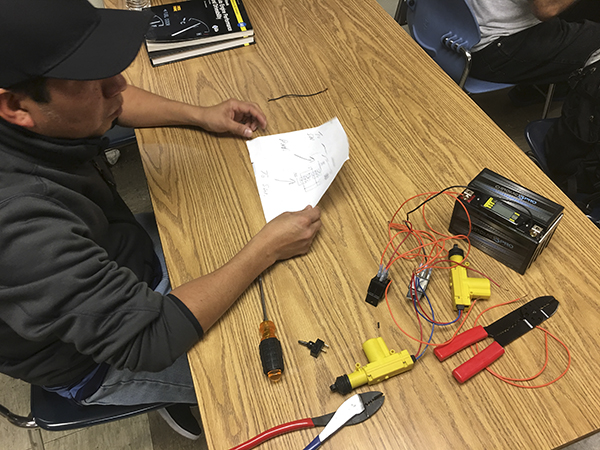Smog-Tech-Voltage-Definition
Smog-Tech-Voltage-Definition
This information is basically for the Smog Tech looking for additional information to help with the level 1 smog tech exam. Explaining only necessary information on electricity, so the level 1 smog tech can understand the voltage definition within a circuit.

Smog-Tech-Voltage-Definition
Electricity is the flow of electrons from one atom to another which surrounds the nucleus which it orbits. The center of the molecule is called the nucleus and contains the protons and neutrons.
Protons have a positive charge, and neutrons have no electrically neutral charge. Every atom contains the same number of electrons and protons.
Smog-Tech-Voltage-Definition
Atoms have different charges; The orbiting electrons have a negative charge, and the protons have a positive charge. The positive charge is indicated by the plus sign (+) and the negative charges by the minus sign ( -)
These are the same symbols that are in an electrical circuit to identify the ground and power sides of a circuit. Every circuit needs a positive and negative charge along with a load device and conductors for the path of current to flow along with protection devices.
Conductors have fewer than 4 electrons in their outer orbit. Copper is the most common conductor in the automotive industry because of the cost.
Examples of other conductors would be silver, gold, aluminum, and steel which is very expensive; you can see the cost of copper compared to gold is a no brainier.
Smog-Tech-Voltage-Definition
Insulators
Now you will need to keep the electrons in place, keep them from jumping around, hold them in place. This material is called an insulator and insulator holds the atoms tightly in place.
Insulators have more than 4 electrons in their atoms outer orbit, and this makes it easier for this material insulator to attract the electrons and not release them. Insulators can be rubber, plastic, porcelain, and rubber.
How do electrons move through a conductor?
Click Here for Smog Inspector Application
Smog-Tech-Voltage Definition
Current
When a battery is placed in a circuit, it is connected to the ends of each conductor wire of the load in the circuit. One end will have a positive charge (lack of electrons) and the other end negative charge (excessive electrons) on the opposite ends of the circuits.
Now current will only flow where there is only an imbalance of electrons excessive electrons at one end and a lack of electrons on the other end of the circuit.
Picture how electrons move, the negative charge electrons will repel free electrons from the atom of the conductor. The positive charge on the opposite end of the conductor will attract electrons.
This is how current flows in a complete circuit, “electrical pressure” remember current doesn't flow in an open circuit.
For example, a broken wire, or blown fuse, a male terminal pin inside of a connector not touching the female plug-in terminals is also considered an open circuit.
Remember in an open circuit there is no current flowing, picture coming across a bridge and there is a break in the bridge everything stops.
Smog-Tech-Voltage Definition
Amperage
Amperage is the unit used to measure current flow, 6.24 Billion Billion electrons flow fits a certain point in a second. Can you imagine anything moving that fast and trying to measure it?
The industrial circuit to measure amperage is called an amp meter. Ampere is the unit of measurement for current flow. "A" and amps are the abbreviation for amperes in today's industry.
Most people think voltage does the work, but ampere is the unit doing the work in a circuit. The actual amperes moving through a load device for an example the light bulb the amperage is doing the electrical work. A and amps are acceptable abbreviations for amps.
Smog Tech-Voltage-Definition
The force that causes electrons to flow through a conductor in known as voltage.
Voltage is the electrical pressure in a circuit, and voltage is the electrical unit that pushes amperage through a circuit. Voltage is also called electrical potential because there is voltage and the possibility for current.
When there are excessive electrons at one end of the circuit, and there is a lack of electrons at the other end of the circuit, there will be a natural effect to equalize the imbalance. This will create pressure to allow electrons to move electrons through a conductor.
Smog-Tech-Voltage-Definition
Ohms
Ohms is the resistance to the flow of current through a conductor, and the unit of measurements is called ohms.
Resistance to the flow of electrons through a conductor is measured in ohms.
The ohms are the unit of measurement for electrical resistance; the symbol for ohms is the Greek letter omega. The symbol used in the calculation is R, for resistance. Ohms are measured by an ohmmeter and resistance to electron flow depends on the material used as a conductor.
Click Here: Smog Tech: Flow Chart
Click Here: Smog Tech: School Website
Another Ohms Law Review Video On understanding the Definition of Voltage Relationship in an Electrical Circuit "Don't Skip"
In this video we are discussing Voltage Drop "Don't Skip"
CLASS SCHEDULES
Emission Control 1:
B.A.R. Smog Check
Inspector Level 1
(Inspector "Smog" License):
Engine Fundamentals
8am - 12:15 pm
Summer Class
7/5/2022 -8/5/2022
Class # 799065
Emission Control 2:
B.A.R. Smog Check
Inspector Level 2
(Inspector "Smog" License):
Rules and Regulations
8am - 12:15 pm
Summer Classes
7/5/2022 - 8/5/2022
Class # 799067
Engine Performance 1:
8am - 12: 15 pm
Date: TBD
Class # 799069
Engine Performance 2:
B.A.R. Specified Diagnostic
and Repair Training
(Repair "Smog" License)
Time: TBD
Date: TBD
Class # 799071
Emission Control 1
(Inspector "Smog" License):
5:00pm - 8:45 pm
Date: TBD
Class # 799065
Emission Control 2:
(Inspector "Smog" License):
5:00pm - 8:45 pm
Date: TBD
Class # 799065
Exhaust Emissions (Update Class):
5:30 pm - 8:45 pm
Tuesday nights:
Dates: coming soon
Class # 796070